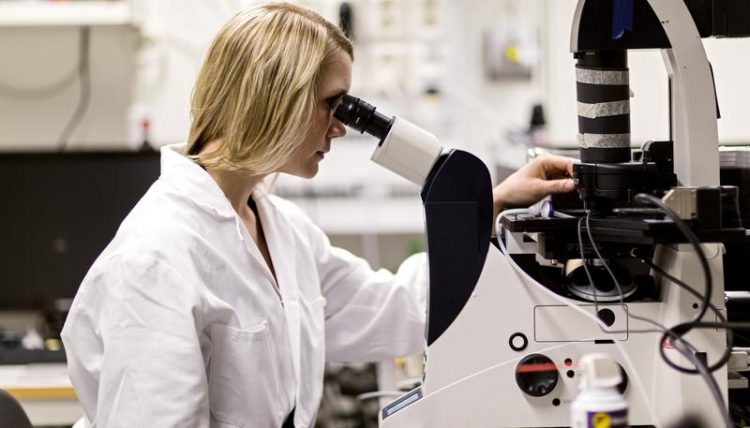Award-winning research on cell metabolism

Anna-Karin Gustavsson, the Department of Physics, University of Gothenburg Photo: Johan Wingborg/University of Gothenburg.
The objective of these research studies is to see what cells do when there are changes in their environment.
A completely new discovery
Anna-Karin Gustavsson has created a specially designed microfluidic chip containing channels through which different solutions are able to flow. With the aid of optical tweezers, a device that traps a laser beam, she captures individual cells for placing at the point where the channels intersect. This intersection between the channels is where the cells' immediate environment can change very rapidly.
“By using a microscope, I have been able to monitor what the cells do when there are changes in their environment. I discovered that the concentration of molecules in the metabolism of individual cells while these are breaking down sugars could, under specific conditions, be made to rock; i.e. oscillate.”
Up to this moment, it had never been possible to demonstrate the monitoring of oscillations in individual cells, despite there being many publications in high-ranking journals.
“The ability to confirm that this takes place in individual, isolated cells is something new,” says Anna-Karin Gustavsson, who together with her colleagues has also produced a mathematical model for the behaviour of the cells during glycolysis, the process whereby sugars are broken down in our cells to create energy.
May influence the designing of new medicines
In both human cells and yeast cells, which are the focus of Anna-Karin's studies, glucose is converted so as to create available energy. These studies may provide a deeper understanding of glycolysis, the way it works and the reason why oscillations occur.
In the past, these oscillations could only be seen in the form of millions of cells gathered in tight clusters and interacting with each other in order to coordinate their oscillations. Studying a population of millions of cells at the same time and on a collective basis produces only a mean value of the behaviour of all the cells, but looking at the cells one by one makes it possible to see that they behave very differently.
“Studying their heterogeneity is important for understanding the way the biological processes work, and provides the knowledge needed for producing new medicines. These glycolytic oscillations in particular are a most interesting area for further study since they may have a connection to the way in which the body secretes insulin, and also to diabetes in cases where this secretion no longer works the way it should.”
When Anna-Karin Gustavsson's discovery was published in the FEBS Journal, her article was judged to be the best in the Young Scientists category, and she was awarded the FEBS Journal Prize for Young Scientists. Since then, she has mapped the way in which the oscillations arise and under which conditions they do so, and the way in which the individual cells interact with each other so as to synchronise their oscillations.
This research has been conducted in Gothenburg and Stellenbosch, South Africa.
Title of thesis: Glycolytic oscillations in individual yeast cells
Supervisor: Dr. Mattias Goksör
Assistant supervisor: Dr. Caroline Beck Adiels
Link to thesis: http://hdl.handle.net/2077/37367
Contact:
Anna-Karin Gustavsson, the Department of Physics, University of Gothenburg
anna-karin.gustavsson@physics.gu.se, (+46) 702-604488
Photo: Johan Wingborg
http://science.gu.se/english/News/News_detail//award-winning-research-on-cell-me…
Media Contact
All latest news from the category: Awards Funding
Newest articles

Silicon Carbide Innovation Alliance to drive industrial-scale semiconductor work
Known for its ability to withstand extreme environments and high voltages, silicon carbide (SiC) is a semiconducting material made up of silicon and carbon atoms arranged into crystals that is…

New SPECT/CT technique shows impressive biomarker identification
…offers increased access for prostate cancer patients. A novel SPECT/CT acquisition method can accurately detect radiopharmaceutical biodistribution in a convenient manner for prostate cancer patients, opening the door for more…

How 3D printers can give robots a soft touch
Soft skin coverings and touch sensors have emerged as a promising feature for robots that are both safer and more intuitive for human interaction, but they are expensive and difficult…





















